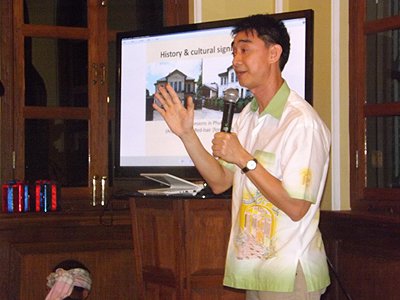Destination marketing: Heritage experts shed light on Phuket’s cultural identity

PHUKET: The American Chamber of Commerce teamed up with the Phuket PR Network last night to present a fascinating and most entertaining culture-preservation lesson at the Blue Elephant in the heart of Old Phuket Town.
The event was headlined by two heritage preservation experts, who gave captivating lectures about the importance of Phuket’s cultural past, present and future.
Dr Yongtanit Pimonsathean, a distinguished architecture and planning lecturer from Thammasat University, shared his knowledge and insights into the origins and evolution of Phuket’s Chinese-European architectural identity.
A specialist in urban environmental planning and development, Dr Yongtanit is recognized for his contributions and research in a vast number of cultural and heritage restoration projects throughout Thailand and Southeast Asia.
With concise chronological delivery, Dr Yongtanit highlighted significant influences on Phuket architecture throughout the last five centuries, from first exposure to European influence with the landing of Portuguese explorers in the 16th century at present-day Tha Reua in Thalang, leading in to the Sino-Siamese settlement establishments in Thalang, which later migrated inland to the less militarily vulnerable Kathu.
Dr Yongtanit shared his interpretation about how Malayan influences entered the mix, triggered by trans-oceanic intermarriage by statesmen, a defining catalyst for the identity of Phuket’s “Peranakan” group.
Simplified locally as ‘Ba Ba – Ya Ya’, the mixed Chinese-Thai-Malay group thrived in Kathu, where a lot of the early and more traditional architectural styles can still be found today.
The center of that population ultimately migrated to present-day Phuket Town, which became the center of thriving commerce.
The professor highlighted how socio-economic evolution was reflected in the development of architectural styles, pointing out how as each generation got richer, the styles got more intricate.
Dr Yongtanit’s speech was followed by a lively and most entertaining presentation by well known Associate Professor Pranee Sakulpipatana, who is also president of the Phuket Community Foundation and vice president of the Thai Peranakan Association.
Prof Pranee teased the crowd with her quick and easy shift to Southern Thai dialect, which she cited as one of the key defining points in the culture under discussion.
“The main and most obvious difference between the Phuket Peranakan and those in Malaysia and Singapore is language. Thai is our mother tongue, for which we owe a lot to General Pi [Field Marshall Piboon Songkran] who made it a strict directive in reaction to a threat of Communism during that time [mid 20th century],” she declared in perfect English.
Effectively using colorful visual aides, Ms Pranee invited a lineup of traditionally-dressed ‘Ya Ya’ ladies – spanning at least three generations, pointing out distinct variations in the bespoke Phuket dress designs of her models.
“In the old days, we didn’t have banks to put all our money in, so we put it on our bodies and clothes as jewelery and decoration.”
Wooing the crowd with effusive humor, Prof Pranee explained that the Ya Ya Phuket ladies on show were all missing one important key ornament.
“The real Phuket lady will also have a set of keys hanging from her hips…. This says [to her husband], ‘So what if you love another woman; I got the keys’.”
Ending her speech on a great note, Ms Pranee powerfully demonstrated the most important defining point of the Thai-Perankan identity.
“Ever since I was a young girl, this song has continued to remind me who I am,” she explained before majestically filling the hall with a local variation of the Sunsern Phra Baramee tribute song to the Thai Monarch, King Bhumibol Adulyadej. She was given a standing ovation.
Latest Thailand News
Follow The Thaiger on Google News:
























